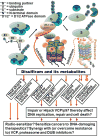Disulfiram combats cancer via crippling valosin-containing protein/p97 segregase adaptor NPL4
- PMID: 30112292
- PMCID: PMC6089232
- DOI: 10.21037/tcr.2018.03.33
Disulfiram combats cancer via crippling valosin-containing protein/p97 segregase adaptor NPL4
Conflict of interest statement
Conflicts of Interest: The authors have no conflicts of interest to declare.
Figures

Comment on
-
Alcohol-abuse drug disulfiram targets cancer via p97 segregase adaptor NPL4.Nature. 2017 Dec 14;552(7684):194-199. doi: 10.1038/nature25016. Epub 2017 Dec 6. Nature. 2017. PMID: 29211715 Free PMC article.
References
-
- Hald J, Jacobsen E. A drug sensitizing the organism to ethyl alcohol. Lancet. 1948;2:1001–4. - PubMed
-
- Johansson B. A review of the pharmacokinetics and pharmacodynamics of disulfiram and its metabolites. Acta Psychiatr Scand Suppl. 1992;369:15–26. - PubMed
-
- Dufour P, Lang JM, Giron C, et al. Sodium dithiocarb as adjuvant immunotherapy for high risk breast cancer: a randomized study. Biotherapy. 1993;6:9–12. - PubMed
-
- Valeriote F, Grates HE. Potentiation of nitrogen mustard cytotoxicity by disulfiram, diethyldithiocarbamic acid, and diethylamine in mice. Cancer Res. 1989;49:6658–61. - PubMed
-
- Brar SS, Grigg C, Wilson KS, et al. Disulfiram inhibits activating transcription factor/cyclic AMP-responsive element binding protein and human melanoma growth in a metal-dependent manner in vitro, in mice and in a patient with metastatic disease. Mol Cancer Ther. 2004;3:1049–60. - PubMed
Publication types
Grants and funding
LinkOut - more resources
Full Text Sources
Other Literature Sources
